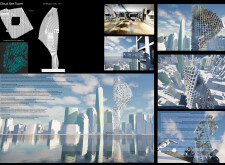5 key facts about this project
## Overview
The Cloud Bee Tower is located in Pumphouse Park, New York City, designed to advance principles of sustainability and urban integration. The project reinterprets traditional skyscraper aesthetics and functionality by merging architectural form with environmental responsibility, aimed at fostering sustainable urban living.
### Design and Structure
The tower features a distinctive twisting form that transitions smoothly along its height. This dynamic profile is engineered to reduce wind load, enhance sunlight exposure, and maximize views of the city. The design incorporates biophilic principles, promoting human interaction with natural elements and prioritizing connectivity to the surrounding environment.
### Material Selection and Sustainability
A diverse range of materials is employed throughout the structure. High-strength concrete provides stability while accommodating the building's unique form. Large, energy-efficient glass facades facilitate natural light entry, creating inviting interior spaces, while lightweight aluminum serves as resilient exterior cladding. Sustainable wood accents enhance the aesthetic appeal in communal and residential areas. The design includes innovative features such as integrated wind turbines for renewable energy generation and rainwater collection systems, reinforcing a commitment to minimizing the urban carbon footprint.
### User Experience and Community Synergy
The layout promotes openness and flexibility, with multifunctional spaces designed to adapt to various community activities. The strategic incorporation of green spaces, balconies, and terraces enhances outdoor living opportunities and invites community interaction. Efficient circulation pathways are integrated to alleviate congestion, fostering a sense of community and connection among residents and visitors.



















































